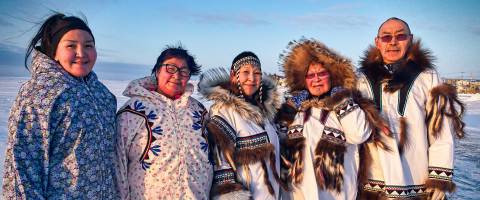The Inuit, also known as the Smith Sound Inuit, are Greenlandic Inuits who were historically known as Arctic Highlanders. They are the northernmost group of Inuit and the northernmost people in North America, living in Greenland. They were previously known as Polar Eskimos. Inuit make up approximately 1% of Greenland’s population.
The Inuit of northwest Greenland had been isolated for several hundred years and were completely unaware of the existence of other humans when contact was made in 1818.
The History of Inuit
The Inuit are thought to be descended from the Thule people, who first appeared in the North American Arctic around the eleventh century. They used and traded iron from meteorites such as the Cape York meteorite. The first discovered Thule settlement was in modern-day Uummannaq. There were also extensive contacts with other Inuit from various regions. Climate change cooled the northwest areas of Greenland in the 17th century, isolating the Inuit from other Inuit regions.
During this time, the Inuit developed their distinct language, culture, and fashion, all of which distinguish them from other Inuit peoples. Around the same time, the Inuit lost the ability and skills to build kayaks or umiaks, which inevitably limited travel and contact with other communities.
Europeans first made contact with the Inuit in 1818, when John Ross led an expedition into their territory. They were dubbed Arctic Highlanders by Ross. They are thought to have previously lived in complete isolation, to the point of being unaware of other humans, and are cited as one of the only non-agricultural societies to have lived without armed feuds or warfare, a state that they maintained after contact. Erik Holtved, a Danish ethnologist, was the first to study the Inuit.
Inuit from Baffin visited and lived with the Inuits in the mid-nineteenth century. Boats, leisters, and bows and arrows were among the technologies reintroduced by the Baffin Inuit after they had been lost to the Inuit. The Inuit, for their part, taught the Baffin Inuit advanced sled technology. In the late nineteenth and early twentieth centuries, American and European explorers had extensive contact with the Inuits.
However, prolonged contact with outsiders altered many aspects of Inuit life, causing a reliance on trade goods and the introduction of new diseases. (Source: Britannica)
What is Their Official Language and How Big is Their Population?
Inuktun is the language spoken by the Inuit. It is a dialect of Inuktitut, an Eskimo-Aleut language closely related to Greenlandic, which is spoken throughout Greenland. Inuktun is also known as Avanersuarmiutut in Kalaallisut, Greenlandic’s official dialect.
The population of these tribes was estimated to be between 100 and 200 people before 1880. They were estimated to number 250 between 1880 and 1930. Their population was estimated to be 700 in 1980, and it increased to 800 in 2010. (Source: Ethnologue)
Are There Still Inuits Around Today?
As of today, there are about 160,000 Inuits across Canada, Alaska, Greenland, and Russia. While people commonly call them Eskimos Canadians officially use the term Inuit to describe all the native people living in the northernmost region of the country. (Source: Seeker)
